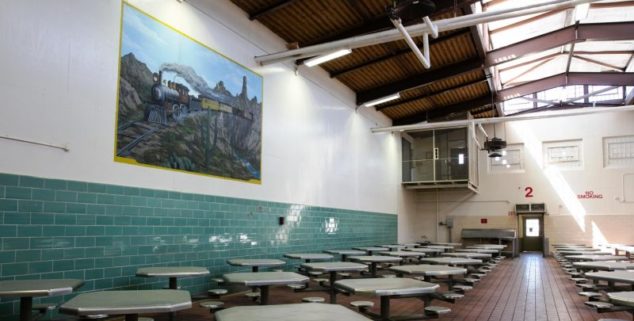News
State ponders prison closures, as inmate population drops.
 A dining room at the Deuel Vocational Institution in Tracy, which closed last year. (Photo: CDCR)
A dining room at the Deuel Vocational Institution in Tracy, which closed last year. (Photo: CDCR)With California’s prison inmate population on a decline, authorities are pondering the closure of three institutions. But many questions remain.
The 2022-2023 state budget notes that there is a possibility of three prison closures during 2024 and 2o25, based at least in part in the reduction of California’s prison population to about 94,000 in prisons and camps.
California’s inmate population more than tripled between 1985 and 2007, according to the Public Policy Institute of California, from about 50,000 inmates to about 173,000 inmates in 2006.
But with inmate populations in decline — it dropped by 26 percent between 2006 and 2018 and is generally flatlining — the state is considering closures.
Other institutions already have been targeted.
Out of California’s 33 state prisons, three face possible closure, officials have noted. The Deuel Vocational Institution (DVI) in Tracy has been closed, and the California Department of Corrections and Rehabilitation (CDCR), said they intend to close the California Correctional Center in Susanville, along with minimum security portions of the California Correctional Institution in Tehachapi and the California Training Facility in Soledad.
The Legislative Analyst’s Office estimates that closing 5 prisons by 2025 could save California about $1.5 billion. The state spends around $104,000 per inmate, and that by closing just one prison, the California Correctional Center, the state will save and estimated $122 million, according to the LAO.
But questions remain. Where will the inmates and employees will go if their prison is closed? Who or what determines which prisons will be closed?
According to CDCR, prison inmates will be transferred to other prisons based on their housing, custody, and rehabilitation needs. The inmates’ rehabilitative, educational, and self-help program credits will be transferred with them.
Employees will be moved based on classification, work location, and seniority score. CDCR said that some employees are subject to layoffs during times of workforce reductions, but noted that there is a voluntary transfer process that allows employees to move to different workplaces to avoid layoffs. There are about 28,000 correctional officers in the state’s prisons.
Prison officials say there are a number of factors involved in deciding which prisons to close.
The state penal code provides guidance on closures. CDCR Secretary Ralph Diaz said the factors include the cost to operate, the impact of the closure on the workplace, housing needs for all populations, long-term investments in state-owned and state-operated correctional facilities; public safety and rehabilitation, and the durability of the state’s solution to prison overcrowding. DVI’s cost to operate was around $182 million.
There is opposition to prison closures.
Glen Stailey, president of the California Correctional Peace Officers Association, said that “adding three additional facilities to the (closure) list will prove to be a tremendous detriment to our state’s public safety.”
He added: “In a state that is flushed with cash, the last thing we should be doing is trying to save a buck in exchange for protecting citizens.”
The city of Susanville opposes the closure of a prison in its area, the California Correctional Center, which houses about 2,300 inmates and is scheduled to close in June 2023. Last year, Susanville challenged the closure in Lassen County Superior Court. A preliminary injunction was issued in September, prohibiting CDCR from taking any action on shutting down the institution.
The injunction remains in effect and the process of closing CCC is currently on hold.
Dean Growdon, the Sheriff-Coroner for Lassen County, expressed his frustrations when asked about prison closures, especially in Lassen County.
“We wish the state would help more with economic development strategies and alternatives to help reduce the prison industries.” He states that in the past, the mining and timber economies were taken away, and now the prison economy is being taken.
The prisons in Susanville play a major economic role in the community, and locals are concerned about the lasting economic effects once they close. Growdon says the county already struggles across the board trying to provide basic services, so closing a major economic powerhouse is detrimental.
He also said that in Lassen County “everyone knows someone who works for the prison and there is nothing planned to replace the prison industry jobs, so lots of people are depressed.”
In addition, Growdon adds that schools are suffering as well. The student population in schools was already dropping previously, but now enrollments are even lower.
—
Editor’s Note: Brieanna Anderson is a Capitol Weekly intern from UC Merced.
Want to see more stories like this? Sign up for The Roundup, the free daily newsletter about California politics from the editors of Capitol Weekly. Stay up to date on the news you need to know.
Sign up below, then look for a confirmation email in your inbox.

Leave a Reply